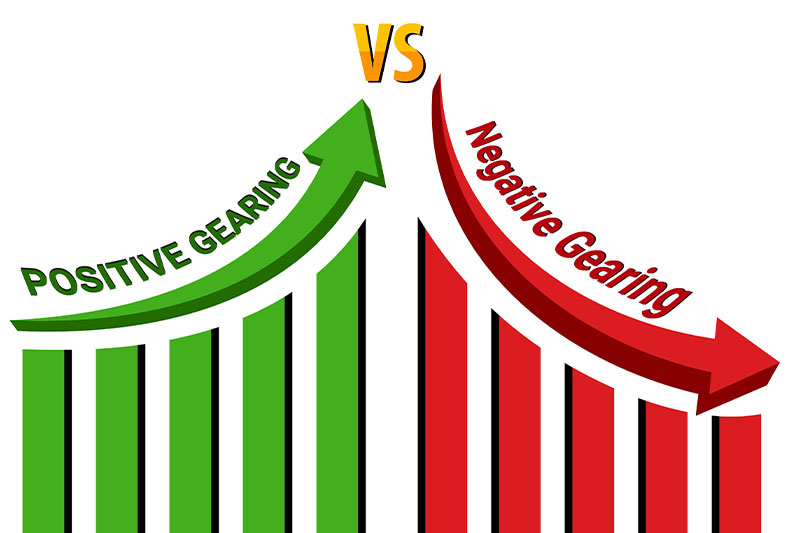
In the world of property investment, gearing strategies play a significant role in shaping an investor’s financial success. But what exactly are positive gearing vs negative gearing, and how do they impact an investor’s bottom line?
In this blog post, we’ll dive deep into these two strategies, comparing their benefits and drawbacks, and providing you with practical insights to make informed decisions on your property investment journey.
Key Takeaways
- This article explores the concepts of positive and negative gearing, discussing advantages and disadvantages for each strategy.
- Factors to consider when selecting a gearing strategy include personal financial situation, property market conditions, long-term investment goals and tax implications.
- Seeking professional advice is recommended to ensure informed decisions regarding property investments.
Understanding Positive and Negative Gearing

But which one is right for you? That’s what we’re here to explore.
Positive Gearing Explained
Positive gearing is the ideal scenario for many property investors, as it generates a consistent income and predictable returns. This occurs when the rental income from a property surpasses the expenses associated with owning and managing it, such as mortgage interest, property taxes, and maintenance costs. Positive gearing occurs when rental rates are high and interest rates remain low. This is due to an increased demand for rental property..
Consider a landlord who receives an annual rent of $20,000 but spends $15,000 on property expenses, including mortgage interest. This results in a profit of $5,000 and additional income for the investor. When considering a positively geared investment property, it’s important to take into account factors like:
- Rental income relative to property expenses
- Risk management
- Tax implications
- Deposit size and purchase price
- The property’s location.
Negative Gearing Explained
Negative gearing, on the other hand, is a strategy that relies on the expectation of capital gain in the long term. In this case, the expenses associated with owning a property, such as mortgage interest, property taxes, and maintenance costs, exceed the rental income generated, resulting in a net loss. However, this loss can be used as a tax deduction against the investor’s taxable income, providing tax savings and reducing the overall costs of property ownership.
This strategy is most advantageous for investors who have a dependable cash flow and additional income, as they can offset their rental losses against other income sources and potentially benefit from capital gains upon selling their investment properties in the future. It’s important that investors have financial reserves available to cover any repayment shortfalls and ongoing costs. Moreover, investors can claim tax deductions on eligible expenses associated with the property, such as loan interest, council rates, and certain maintenance costs.
Pros and Cons of Positive and Negative Gearing

Benefits of Positive Gearing
Positive gearing offers several advantages, including:
- Immediate returns
- Self-financing investments
- The possibility of capital growth
- No requirement for extra financing for operational expenses
The immediate returns that come with positive gearing are a result of the rental income surpassing the property expenses, thus generating a surplus of income over expenses and leading to immediate cash flow and returns.
In terms of self-funding investments, the excess rental income generated from a positively geared property can be used to cover the costs of the investment, allowing it to be self-funded. Furthermore, positive gearing can contribute to potential capital growth through increased cash flow, equity accumulation, and value-added improvements to the property.
Drawbacks of Positive Gearing
While positive gearing offers attractive benefits, it also comes with its share of drawbacks. Some of the potential challenges associated with positive gearing include tax obligations and slower long-term growth in comparison to negative gearing. With positively geared properties, the rental income generated is considered taxable income, which means investors may end up with higher tax liabilities.
Additionally, positive gearing could be less advantageous for long-term property investors due to the potential loss of tax benefits and the risk of investing in properties with low capital growth. As such, it is essential to carefully weigh the potential risks and rewards before adopting a positive gearing strategy.
Benefits of Negative Gearing
On the flip side, negative gearing offers some notable advantages as well, including tax deductions, the potential for long-term capital growth, and the opportunity to invest in additional assets. Tax deductions for negatively geared properties allow investors to offset rental losses against other income sources, reducing their overall taxable income and providing tax savings.
In terms of long-term capital growth, negative gearing can facilitate this by enabling investors to maintain ownership of the property for an extended period, even if it produces a negative cash flow in the short run. As property values increase over time, investors may benefit from capital gains when they dispose of the property, leading to long-term capital growth.
Drawbacks of Negative Gearing
Negative gearing comes with certain risks associated with a negatively geared property. We cannot ignore them. Some potential drawbacks include financial risks, reliance on property value appreciation, and the need for a cash buffer to cover ongoing shortfalls. The strategy relies heavily on property values appreciating over time, which may not always be the case, leading to financial losses for the investor.
Furthermore, negative gearing may result in persistent deficits in rental income, which can be challenging to address without having a cash reserve. This cash reserve can assist in covering the expenses associated with owning the property, such as mortgage interest and upkeep, until the value of the property increases, and the investor can reap a benefit.
Factors to Consider When Choosing a Gearing Strategy

We’ll examine each of these factors in the subsequent sections to see how they can steer your decision-making process.
Personal Financial Situation
An assessment of your financial status is a pivotal step before deciding on a gearing strategy. Factors to consider include income, debts, and risk preferences. Your risk tolerance plays a significant role in selecting a gearing strategy. Investors with higher risk tolerance tend to favor a higher gearing ratio, which involves a greater use of debt to finance investments. This may lead to higher returns but also poses a greater financial risk.
Conversely, individuals with lower risk tolerance may opt for a lower gearing ratio, which involves less debt and a lower financial risk. Ultimately, the decision of which gearing strategy to pursue depends on your risk appetite and your willingness to accept the associated risks and potential rewards.
Property Market Conditions
The current conditions of the property market are another vital element to consider when choosing a gearing strategy. Factors such as rental yields, capital growth potential, and regional variations can all impact the success of a given strategy. For example, positive gearing may be more favorable in a market with strong rental demand and low interest rates, whereas negative gearing may be more suitable in a market with high capital growth potential.
It’s essential to keep an eye on market trends and conditions, as they can influence the effectiveness of your chosen gearing strategy. Being knowledgeable about the property market and staying updated on current trends will help you make informed decisions and adapt your strategy as needed.
Long-term Investment Goals
Based on the provided text, I have split it into two paragraphs:
Paragraph 1: Lastly, your long-term investment goals and how they align with positive or negative gearing strategies should be given careful consideration. Whether you aim to build a property portfolio, generate passive income, or achieve financial freedom, understanding the potential outcomes of each strategy can help you make an informed choice.
Paragraph 2: For instance, positive gearing can facilitate wealth accumulation and expedite the attainment of financial objectives, while negative gearing may offer potential long-term capital growth and tax savings, depending on various factors. By evaluating your long-term investment goals and understanding how they correlate with each strategy, you can make a more informed decision and optimize your property investment journey.
Tax Implications of Positive and Negative Gearing

We will delve into the tax ramifications of each strategy in the subsequent sections.
Tax Deductions for Negative Gearing
As previously mentioned, tax deductions are one of the key advantages of negative gearing. Investors can offset rental losses against other income, reducing their overall taxable income and providing tax savings. Tax deductions for negatively geared properties can include expenses such as:
- Rental advertising costs
- Loan interest
- Council rates
- Land tax
- Property management fees
- Repairs
- Maintenance expenses
These deductions can be particularly beneficial for investors who have other income sources, as they can help to reduce the overall tax burden and facilitate further investment opportunities.
Tax Obligations for Positive Gearing
For positively geared properties, tax obligations include paying income tax on net rental income. This tax liability can be calculated by subtracting the expenses associated with owning the property, such as mortgage repayments, maintenance costs, and property management fees, from the rental income received.
The net rental income is then subject to income tax at the owner’s applicable marginal tax rate. While positively geared properties can provide immediate cash flow and returns, it’s important to consider the tax obligations and weigh the potential benefits and drawbacks before choosing this strategy.
Seeking Professional Advice

- Navigate the property investment landscape
- Assess your individual financial situation
- Provide personalized advice tailored to your specific goals and circumstances
By consulting with experts, you can ensure you’re making the best possible decisions for your property investment journey.
Case Studies: Positive and Negative Gearing in Action

Summary
In conclusion, positive and negative gearing are two contrasting strategies in property investment, each with its own set of benefits and drawbacks. By carefully considering factors such as your personal financial situation, property market conditions, and long-term investment goals, along with understanding the tax implications and seeking professional advice, you can make informed decisions that best align with your financial objectives. Regardless of which strategy you choose, always remember to stay informed, adapt to market changes, and be prepared to adjust your strategy as needed to maximize your property investment success.
Frequently Asked Questions

Is negative gearing better than positive gearing?
Negative gearing can be a beneficial strategy for some tax-savvy investors as it could reduce your taxable income, however you will need to cover the shortfall out of pocket. Overall, positive gearing may be more logical, but negative gearing may still be an option for some.
What are the disadvantages of positively geared property?
Positively geared property comes with some risks and drawbacks, such as reduced tax benefits, increased risk of low capital growth properties, and slim profits.
Who benefits most from negative gearing?
Negative gearing provides the greatest benefit to those over 40, resulting in a double disadvantage for younger people.
What is the difference between positive and negative gearing?
Positive gearing is when the rental income from a property exceeds associated expenses, creating a profit, while negative gearing is when the expenses outweigh rental income resulting in a net loss. Each has its own benefits and drawbacks, so the choice depends on the investor’s goals and financial situation.
What factors should be considered when choosing a gearing strategy?
When selecting a gearing strategy, it is important to consider personal financial circumstances, property market trends, and desired long-term objectives. Tax implications should also be taken into account, as well as professional advice.













